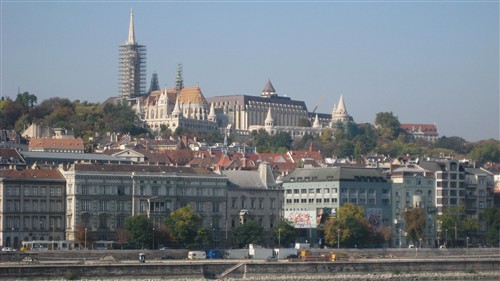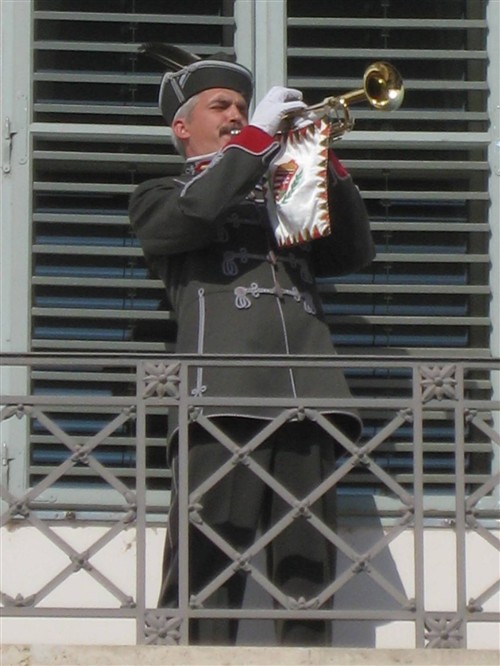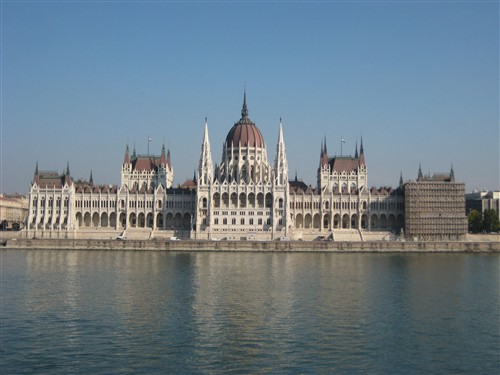Posted under Hungary

Our first hours in Budapest bore an unexpected twist. From the train station, we followed the directions that had been emailed from the owner of the flat that we would be renting for four nights. We reached the building – an old, dilapidated multi-story building with an open courtyard in the center. George likened it to an L.A. apartment building. I thought it looked like something out of Scarface.
Just as we were organizing ourselves in the entryway, two young men called down from a top floor interior balcony and beckoned us upstairs. We pondered this as we glanced over our collective albatross of necessities and, before we could nominate a representative to go up, the men offered to come down. After the cursory introductions, they explained in heavily-accented English that there was a problem with the flat that we’d reserved but they had called a taxi to take us to another flat on the other side of town. After a barrage of questions, we agreed to take the taxi while the owner, Adam, would ride his bicycle to meet us at the other flat.
Adam managed to arrive before us and his associate, Aggie, a chic, raven-haired beauty, was waiting at the door to greet us. The flat was on the third floor of another old building with no lift, making for a killer climb with our heavy load. Our efforts were rewarded at the top. The spacious flat, comprising one-quarter of the third floor, was funky, eclectic and thoughtfully decorated. The place oozed character. As we completed the check-in process in the Bohemian common room, appointed with interesting antiques and old black-and-white family photographs in dusty frames, we learned that Adam was a painter, a painter of churches to be exact, and all of the other people we’d met so far were painters of varying media as well. They had all attended art school together. We found this all fascinating and felt tickled to have already penetrated a vibrant layer of Budapest culture.

Today’s Budapest is the product of an official merger of three smaller cities that had naturally grown together: Buda, a hilly expanse with affluent neighborhoods and a magnificent skyline composed of the old royal palace, the tree-covered Gellert Hill, neo-Gothic churches, and most of Budapest’s remaining medieval buildings; Pest, the flat, modern commercial and cultural center; and Obuda, an old Roman settlement dating back to the first centuries.
The Danube River, as sparkling green as a glacial lake, separates Buda and Obuda on its west bank from Pest on its east bank. The two sides are connected by nine bridges that span the Danube, the prettiest of which is the Chain Bridge with sculptured guardian lions and a chain of lights that reflects on the water at night.
Hungary’s history is colored by foreign influences from a succession of foreign governance, an alliance with Nazi Germany (430,000 Hungarians were transferred to Auschwitz, more than any other nationality), and the dark curtain of Soviet-style Communism. The current Republic of Hungary was proclaimed in 1989 and the last Soviet troops left in 1991. Democratic elections were held and a free market economy emerged. While the signs of modernization and growth abound in Budapest, remnants of the past are ever-present in the form of decadent Turkish baths, Viennese coffee houses, Hapsburg elegance in architecture, and a graveyard for Socialist statues called Szobor Park. The statues, which formerly stood in various places around the city, were deemed inappropriate in the early ‘90s and moved to the statue park on the outskirts of town.
 On our first morning, we all purchased three-day unlimited public transport passes and began to explore the city. We began our foray into Budapest culture at Varosliget, the city park in the north of Pest. The vast greenspace enclosed a peaceful lake, a zoo, a children’s circus, an exhibition hall, a fine arts museum and a public bath. We walked under a canopy of autumn trees to a daily flea market that Jennifer had read about. The old saying “One man’s trash is another man’s treasure” was manifest in Varosliget that day as we wandered along row upon row of rummage tables. George and Aaron lost interest almost immediately and disappeared into the park to smoke cigars. The treasures laid out for my perusing pleasure, in addition to the usual used clothes, shoes, books and household items, included jewelry, antiques, kitschy Hungarian handicrafts and knickknacks. Surely there lurked some shiny treasures amid the embroidered linens and ceramic figurines but I didn’t have the patience to dig for them and soon joined the men who had made it as far as the first tree outside the flea market before copping a squat and lighting up.
On our first morning, we all purchased three-day unlimited public transport passes and began to explore the city. We began our foray into Budapest culture at Varosliget, the city park in the north of Pest. The vast greenspace enclosed a peaceful lake, a zoo, a children’s circus, an exhibition hall, a fine arts museum and a public bath. We walked under a canopy of autumn trees to a daily flea market that Jennifer had read about. The old saying “One man’s trash is another man’s treasure” was manifest in Varosliget that day as we wandered along row upon row of rummage tables. George and Aaron lost interest almost immediately and disappeared into the park to smoke cigars. The treasures laid out for my perusing pleasure, in addition to the usual used clothes, shoes, books and household items, included jewelry, antiques, kitschy Hungarian handicrafts and knickknacks. Surely there lurked some shiny treasures amid the embroidered linens and ceramic figurines but I didn’t have the patience to dig for them and soon joined the men who had made it as far as the first tree outside the flea market before copping a squat and lighting up.
It was a glorious sunny day and, when Jennifer had rejoined us, we walked through the park toward Andrassy Avenue – a lovely, tree-lined avenue stretching from Heroes Square in the city park to the commercial center of Pest. The avenue was lined with fine old buildings including the gilt-laden Hungarian State Opera House, Kodaly Korond (a statue-clad square with beautifully painted old buildings), and a quartet of identical buildings, the facades of which created a grand octagonal intersection. Beneath Andrassy Avenue runs Continental Europe’s oldest underground railway – Budapest’s M1 yellow line metro. The line’s seven stops under Andrassy have their original interior from the 1970’s with red-and-white tiled walls and floor-to-ceiling wood cabinets.
We had taken lunch outdoors at an Italian place on Andrassy and were jonesing for a sweet, so much so that we began singing songs about cake. When we realized that we were very near Budapest’s historical cake-and-coffee venue, our walk became a skip, and when we spotted the lovely patio tables and exquisite façade of Gerbeaud, Jennifer and I were tickled while Aaron and George’s mental cash registers were already ringing. We sat for a round of pretty but mediocre cakes, listening as a shabbily-dressed man played a violin in the square.
We concluded the afternoon with a walk to the eastern bank of the Danube, near the Chain Bridge. When we first laid eyes on the Buda skyline, we were awed by its beauty. The Buda royal palace stood majestically atop Castle Hill while the colorful tiled roofs of the Buda Reformation Church and Matthias Church shone among the medieval stone facades. The Danube, in contrast to Prague’s sleepy River Vltava, is a commercial artery. Cargo barges, piled high with shiny black coal, glided through the center while cruise ships and riverboat restaurants lined the banks. We soaked up the stunning views and then ambled back to our little painter’s flat to cozy up for the evening.
 Intrigued by the sleepy hills of Buda, Aaron and I set out the next morning for a closer look. We walked across the Chain Bridge and rode the funicular up to Castle Hill. Too antsy to join the royal palace tour, we joined the crowd to watch the daily changing of the guard, took in the views of Pest from the hill, and then wandered through the old streets. I popped into Matthias Church, known as much for its magnificent interior murals as its kaleidoscopic tiled roof. Our final stop in Buda was the riverbank across from Budapest’s most photographed architectural masterpiece – the Parliament. After Budapest was united in 1873, the design of the House of Parliament was conceived as a symbol of the sovereignty of the nation. With its central dome and Gothic turrets, it stands as boldly on the western embankment of the Danube, its reflection almost pristinely cast on the river’s calm surface.
Intrigued by the sleepy hills of Buda, Aaron and I set out the next morning for a closer look. We walked across the Chain Bridge and rode the funicular up to Castle Hill. Too antsy to join the royal palace tour, we joined the crowd to watch the daily changing of the guard, took in the views of Pest from the hill, and then wandered through the old streets. I popped into Matthias Church, known as much for its magnificent interior murals as its kaleidoscopic tiled roof. Our final stop in Buda was the riverbank across from Budapest’s most photographed architectural masterpiece – the Parliament. After Budapest was united in 1873, the design of the House of Parliament was conceived as a symbol of the sovereignty of the nation. With its central dome and Gothic turrets, it stands as boldly on the western embankment of the Danube, its reflection almost pristinely cast on the river’s calm surface.
We made a brief stop in the old Jewish Quarter on our way back to the flat to glimpse the beautiful Nagy Synagogue with its weeping willow-shaped memorial to those who perished in the Nazi death camps. The Holocaust museums and memorials always stir up intense emotions and require subsequent moments of quiet reflection. Back at the flat, we all agreed that a siesta was in order before dinner. I will never take for granted the pleasure of having a comfortable place to hang your hat. In the hostel world, we have not always had that. I must take this opportunity to shower our dear Jennifer with kudos for booking our excellent accommodation in Eastern Europe. I cherished lovely hours of down time in all of them, especially the accidental painter’s flat.
Dinner that night was Hungarian. We had passed by the place a half-dozen times and its red-and-white tablecloths finally lured us in. We were greeted at the door by the humble, white-haired proprietor, who ushered us to a table by the window. There were ten or twelve tables in the place, about of half of which were occupied, and our black suit-clad host waited on every one personally. We gobbled down some delicious rolls while we waited for our entrees – meaty goulash and hearty, slow-cooked meats. Dinner was authentic and spectacular!

For our last day in Budapest, I had the grandest plans: a late morning visit to the Szechenyi public bath in the city park, dinner at the recommended restaurant Menza, and an evening performance of La Tosca at the opera house. George and Jennifer showed little interest, with the possible exception of dinner, but Aaron was a willing participant. That morning, however, an unwelcome wave of lethargy swept over us. It was midday by the time we packed our day pack and headed for the bath.
As we waited in the line of senior citizens at the admissions window – a line that failed to progress more than three steps in fifteen minutes – our lethargic brand of enthusiasm began to wane. Aaron prodded me to peek through the window to steal a glimpse of the main pool. It was surrounded by yellow walls and white columns – the layout was decadent and aesthetically pleasing. The entire perimeter of the pool was crowded with old men, though I could see several younger patrons, including some women, in the center. I returned to the line, which had not budged in my absence. When Aaron confessed a few minutes later that his interest was half-hearted, I turned and walked out, knowing that I would regret the impulsive fold but powerless to stop myself.
I attributed part of my emotional demise that day to a gradual assessment that I had been making of my physical state. Aaron and I were unintentionally setting a trip record for longest time without washing our clothes and we were both getting irritated about our dingy duds. For posterity, I feel compelled to add here that I did wash undergarments in the sink twice during this period. I hadn’t had a haircut since China and, while I have liked my long locks, they were becoming rather unruly. My razorblade had been dull for quite some time and I was out of replacements. As icing on the cake of my aesthetic fall from grace, I had somehow lost my last contact lens (yes, I only wear one; Aaron’s “little cyclops”) that morning. I was falling apart. Sensing that I was on the brink of a nasty mood swing, my darling husband led the charge in putting Humpty Dumpty back together again.
We decided to bag the bath and the opera. We took the metro back to town, sat down for a quick lunch, paid an extortionist’s price of $10 for two razorblades, and then stopped into an optometry shop for new contact lenses. While the optometrist spoke about as much English as I speak Hungarian (i.e. I asked questions in English; she answered in Hungarian), we managed to get the deal done with surprising efficiency. While our last day in Budapest fell drastically short of my cultural aspirations, the grapes of my wrath were slowly fermenting.
Our foursome did go to Menza that night for a magnificent Hungarian farewell dinner. Hungarian beers, rich soups and the quintessential meaty mains were the finishing touch on an unforgettable foray through Eastern Europe.
As for my final thoughts on Budapest, I cannot provide them because to do so would imply that I will not return. I hope to return someday for a bath and an opera. Instead, my parting thoughts are as follows: Budapest is a city that begs to be explored. The intrigue of its history, baths, spas, restaurants, and Bohemian pulse is too deep to uncover in a mere four nights (minus one for emotional wavering). Budapest manifests both the scars of war and the audacity of hope. Relaxed and livable, artsy and inspiring, surprisingly beautiful…that is Budapest.
Comments Off on Budapest
